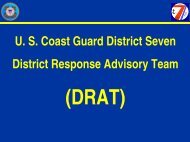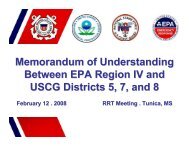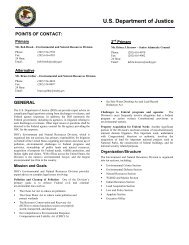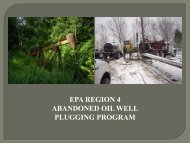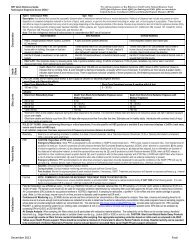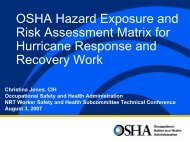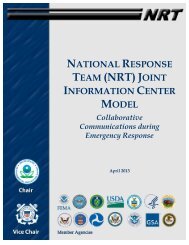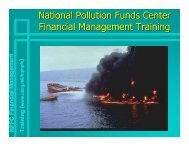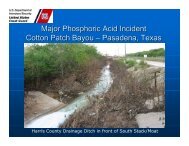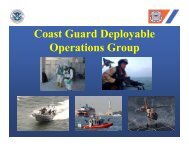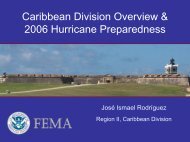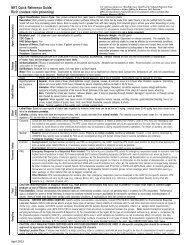GENERIC SITE SAFETY PLAN FOR DISPERSANT OPERATIONSATTACHMENT #1ENVIRONMENTAL MONITORING FOR CHEMICAL HAZARDS:The following monitoring shall be conducted. Monitoring equipment shall be calibrated andmaintained in accordance with the manufacturer's instructions (electronic equipment shall becalibrated before each day's use).INSTRUMENTFREQUENCY__ Combustible gas___continuous, ___hourly, ___ daily, Other:__ Oxygen___continuous, ___hourly, ___ daily, Other:__ HNU___continuous, ___hourly, ___ daily, Other:__ OVA___continuous, ___hourly, ___ daily, Other:__ WBGT/heat stress___continuous, ___hourly, ___ daily, Other:__ Noise___continuous, ___hourly, ___ daily, Other:__ H2S Monitor___continuous, ___hourly, ___ daily, Other:__ other chemical specific monitors(colorimetric/electronic):1. ___continuous, ___hourly, ___ daily, Other:2. ___continuous, ___hourly, ___ daily, Other:
GENERIC SITE SAFETY PLAN FOR DISPERSANT OPERATIONSATTACHMENT #2AIRCRAFT SAFETYThe acute hazard of aircraft related accident seems to be the major health and safety concern in dispersantobservation. Care must be taken that the observation aircraft will not fly close to the aircraft applying the dispersant.All flight must be well coordinated, and safety distance must be kept at all times.CHOICE <strong>OF</strong> PLATFORMSHelicopters are often the aircraft of choice during spill response. Fixed wing aircraft may be used, however, asobservation or application platforms. An important consideration for flying aboard any aircraft type is whether or notyou are adequately prepared for emergency landings in the event of equipment problems. Multi-engined aircraft arealways preferred and offer a much higher degree of safety, especially when operating over water. Floats on ahelicopter may be comforting and provide some degree of safety but are often inadequate in rough or rolling seas. Ifsingle engine aircraft are used, operations should be adjusted to account for the possibility of a forced landing. Oneoption is to operate only within a reasonable distance to shore and at an altitude that would allow for an emergencyno power landing. Another option is to operate only in conjunction with vessels equipped with monitoringcommunications and able to affect a quick rescue response. In all cases appropriate safety and flotation equipmentshould be worn. Keep in mind that in time of emergency you will not have time to put on your flotation vest or grabthe emergency locator. You better have it on you at all times while in flight.HELICOPTER SAFETYBEFORE YOU BOARD...Notification: Notify the person in charge (OSC, XO, flight ops, SSC etc.) of the flight purpose, destination, andestimated time of return.Safety brief: Make sure that you and the other passengers get a thorough safety briefing before you fly. It shouldinclude general information about the flight, safety features and how to use them, and emergency procedures. Don'tforget to take a good look at the aircraft. Rusty rotor blades or improvised repairs may be an indication of poormaintenance. If you are not satisfied with what you see or hear, get another aircraft or pilot.Safety gear: Prepare your personal safety gear (NOMEX suit, flotation vest, emergency locator, etc.) and make sureit works. Make sure you wear your safety gear (flotation vest, survival equipment) at all times while in flight. Youwill have no time to put it on in time of emergency.Brief the pilot: The team leader should brief the pilot on mission details: Where you want to fly, preferred altitude,landing site, number of people, the purpose of the mission, route, estimated weight of people and gear, geardeployment if needed, and other pertinent details. If possible tell the pilot you would like to do your observationsthrough an open window, plan your flight path so you minimize the time you will be looking up sun.Equipment: Take appropriate map/charts with you to sketch the extent of the spill you observe; the ability tocommunicate with the pilot during the overflight is important to optimize the overflight observations. Take cameraand/or video for documenting what you see. It is helpful if a second person can do the photography.BOARDINGIt is best to board the helicopter when the rotor is stationary. Often it is not possible. If there is a crew member toassist you, follow his/her instructions. If not, board as follows:
- Page 2 and 3:
UPDATES AND CHANGESCHANGE OR UPDATE
- Page 6 and 7:
CARIBBEAN REGIONAL RESPONSE TEAMPOL
- Page 9 and 10:
SECTION IPurposeThis policy provide
- Page 11 and 12:
2. YELLOW ZONE - WATERS REQUIRING C
- Page 13 and 14:
SECTION IIIProtocolsTHE FOLLOWING R
- Page 15 and 16:
APPENDICES
- Page 17 and 18:
Caribbean Regional Response TeamDis
- Page 19 and 20:
Caribbean Regional Response TeamDis
- Page 21 and 22:
Caribbean Regional Response TeamDis
- Page 23 and 24:
Caribbean Regional Response TeamDis
- Page 25 and 26:
Caribbean Regional Response TeamDis
- Page 27:
Caribbean Regional Response TeamDis
- Page 30 and 31:
Caribbean Regional Response TeamDis
- Page 32 and 33:
CommanderSeventh Coast Guard Distri
- Page 34 and 35:
mile from any reef which is less th
- Page 36 and 37:
high exposure levels, volatile hydr
- Page 38 and 39:
a few days or weeks, unmetabolized
- Page 40 and 41:
1990. Geraci, J.R. and D. J. St. Au
- Page 42 and 43:
CommanderSeventh Coast Guard Distri
- Page 44 and 45:
Biological Assessment of Effects on
- Page 46 and 47:
The dispersed oil droplets, ranging
- Page 48 and 49:
Sea TurtlesSea turtles can be expos
- Page 50 and 51:
Most aquatic organisms have the abi
- Page 52 and 53:
Ernst, C.H., J. Lovich, and R.W. Ba
- Page 54 and 55:
Appendix IIIDispersant Use Monitori
- Page 56 and 57:
Dispersant Use Monitoring Program w
- Page 58 and 59:
APPENDIX IVDispersant Use Decision
- Page 60 and 61:
- dispersant composition;- water sa
- Page 62 and 63:
For Puerto Rico:1) the waters are n
- Page 64 and 65:
DOCUMENTATION/APPLICATION FORM FORD
- Page 66 and 67:
2. Type of aircraft used __________
- Page 68 and 69:
Letter of AgreementCommonwealth of
- Page 70 and 71:
300. SCOPE301. The USCG, USEPA, USD
- Page 72 and 73:
debriefing will gather information
- Page 74 and 75:
LETTER OF AGREEMENTON LIMITED USE O
- Page 76 and 77: LETTER OF AGREEMENTON LIMITED USE O
- Page 78 and 79: minimize substantial threat to publ
- Page 80 and 81: Appendix VIDispersant Use Operation
- Page 82 and 83: APPENDIX VIDispersant Use Operation
- Page 84 and 85: APPENDIX VI TABLE OF CONTENTSSECTIO
- Page 86 and 87: ICS DISPERSANT USE ORGANIZATIONAL R
- Page 88 and 89: DISPERSANT USE DECISION / IMPLEMENT
- Page 90 and 91: DISPERSANT APPLICATION PLATFORM CAP
- Page 92 and 93: DISPERSANT APPLICATION OPERATIONAL
- Page 94 and 95: DISPERSANT OPERATION PLAN CHECKLIST
- Page 96 and 97: GENERAL:OBSERVATIONS:PHOTOGRAPHY:In
- Page 98 and 99: Incident CommanderOperations Sectio
- Page 100 and 101: DISPERSANT / APPLICATION FORM FROM
- Page 102 and 103: DISPERSANT / APPLICATION FORM FROM
- Page 104 and 105: [This page intentionally blank]
- Page 106 and 107: • Comply with the dispersant use
- Page 108 and 109: • Coordinates and is lead for any
- Page 110 and 111: SPRAYER LOG SHEET(Completed by Spra
- Page 112 and 113: OBSERVATION AIRCRAFT / VESSEL / "OB
- Page 114 and 115: • The visibility of the dispersed
- Page 116 and 117: Duration of FlightPreferred Altitud
- Page 118 and 119: DISPERSANT OBSERVATION FINAL REPORT
- Page 120 and 121: SITE SAFETY PLAN TEMPLATE FOR DISPE
- Page 122 and 123: Adequate protection may be achieved
- Page 124 and 125: (404)639-0615 (24 hr) (voice) 0655
- Page 128 and 129: • From a safe distance (at least
- Page 130 and 131: SAFE APPROACH TO A HELICOPTERAPPROA
- Page 132 and 133: c. Optimum storage temperature rang
- Page 134 and 135: X. ANALYSIS FOR HEAVY METALS AND CH
- Page 136 and 137: wear long sleeve shirt, chemical re
- Page 138 and 139: 8. Solvents: CONFIDENTIAL9. Additiv
- Page 140: ___ rubber steel toe/shank safety b



